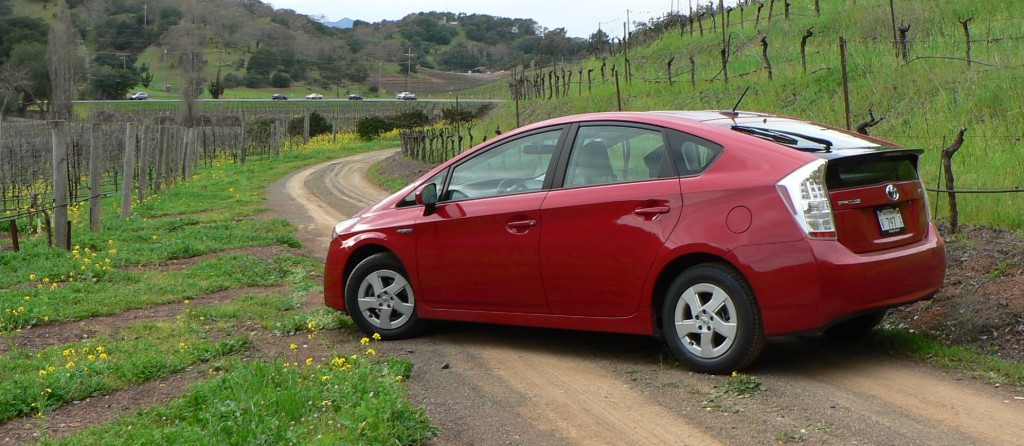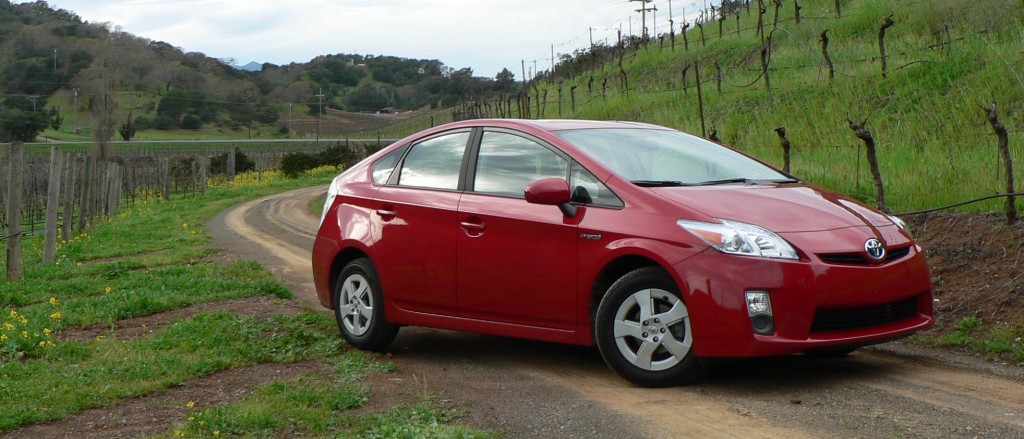First Drive: 2010 Toyota Prius
Story and photos by John LeBlanc
YOUNTVILLE, Calif.–With more than one million sold worldwide – about 14,000 in Canada since 2000 – the Prius has become the best-selling, most-recognizable hybrid in the world, and a halo car casting Toyota in an eco-friendly light.
When Toyota was developing the third-generation 2010 model, the previous generation Prius’s increasing popularity presented a “problem” that was the envy of other automakers. How do you keep all your original eco-conscious customers, while at the same time enticing new buyers who would normally choose a traditional gas-only car?
“With this third generation, we wanted to make the Prius more of an aspirational car, more mainstream, more familiar for first-time hybrid buyers,” said Stephen Beatty, managing director of Toyota Canada, at the media launch of the Prius, held here in one its best-selling markets.
Translated, “aspirational” means there are more comfort and convenience packages available for the 2010 Prius, mainly to fulfil the desires of all those up-market luxury car buyers attracted to the class-free hybrid.
Some of these new features include leather seating, navigation system with backup camera, Dynamic Radar Cruise Control (which adjusts vehicle speed, applies light braking if necessary and warns the driver to take evasive action if a crash is imminent), sliding glass moon roof with solar panels that power a new ventilation system, and Intelligent Parking Assist (that guides the car into a parallel parking space).
Pricing will be announced closer to its on-sale date this spring. The 2009 Prius started at $27,710.
All Toyota Canada is saying for now is that it’s “always tried” to keep the base price of the Prius around the average price of a new passenger vehicle in Canada. In 2008, that was $30,877, down 2.6 per cent from a year earlier.
With all the new options, a loaded 2010 Prius could end up pushing $40,000.
In parking lots filled with minivans, SUVs and pickups, the previous model’s iconic looks made it stand out like Wayne Gretzky in a beer league hockey game.
On the new model, the hybrid’s humpback profile survives, and the rear design has changed little. Just as on Honda’s new Insight hybrid, the wind tunnel dictates the Prius’s high rear deck and duckbill spoiler.
Yet up front, there are more significant changes. There’s a larger Toyota logo dropped into the small grille on a metal tongue, a pair of boomerang headlights, fake vertical air inlets towards the outer edges of the bumper and a deep horizontal swath down its sides.
Other than that, the 2010 Prius is still a front-wheel-drive, five-passenger midsize five-door hatchback, about the same size as the 2009 model in most dimensions.
Inside, the 2010 model’s cockpit remains familiar – including the centrally located driver’s instrumentation that still requires you to take your eyes off the road to read.
But at least the continuously variable transmission gear selector is now angled towards the driver. And there’s some storage space underneath the centre console.
There’s also a bit more room in the back seat. And Toyota says you can now get three, instead of just two, golf bags in the hybrid’s rear hatch.
Despite these evolutionary changes in form, Toyota’s approach with the new Prius respects the last model’s key function: to deliver extremely low fuel consumption and tailpipe emissions.
There’s still a wee four-cylinder gas engine helped along by an electric motor. A 98 hp, 1.8-litre four-cylinder engine replaces the 1.5 L unit from the 2004-2009 Prius.
New, though, are three configurable driving modes: EV-Drive Mode allows driving on battery power alone under 40 km/h for about 1-2 km; Power Mode increases sensitivity to throttle input for swifter acceleration; and Eco Mode adjusts the throttle with a bias towards better fuel economy.
All of this results in the 2010 Prius getting fuel consumption ratings better than the previous version (see accompanying story).But the bigger surprise is how much better the new Prius drives.
The first two Prius generations’ “fuel-economy or bust” engineering left the car with a few compromises that confused new owners who were used to driving traditional gas-only cars.
Its CVT whined like a laundry washing machine on spin. At low speeds, the hybrid’s regenerative brakes (that feed braking energy back to the battery) were grabbier than a kleptomaniac.
And the old Prius’ high centre of gravity combined with narrow, low rolling resistance tires, meant any driving experience could be described in one word: understeer.
Granted, you won’t confuse the new Prius as the rebirth of the Toyota Supra Turbo. But it now drives less like a science class experiment and more like a “normal” car.
The 2010’s bigger engine produces a lot more torque, now 105 lb.-ft., versus 82. That helps cut its 0-to-96 km/h time by about a second, to 9.8 seconds (or about a half-second quicker than the VW Jetta TDI or Honda’s new Insight hybrid).
More relevant, though, the additional grunt at lower revs also lessens the old continuously variable transmission’s annoying drone. The 2010 version offers better brake pedal feel, while the steering is less artificial and has more feel off-centre. And its new chassis setup means it doesn’t laterally roll like a dinghy in a storm during spirited cornering.
Northern California is the heart of Prius nation, with samples of the previous generation easily found on almost every street, so the new model blends right in.
And now, with its improved performance and handling, the 2010 Prius is better able to keep up with the BMWs, Audis and Mercedeses in this upscale part of the U.S.
If Toyota’s goals were to increase fuel economy, raise performance and make the car more appealing to “mainstream” buyers, it’s hard to find fault with the result.
2010 Toyota Prius
PRICE: est. $30,000 – $40,000
ENGINE: 1.8 L I4/electric motor
POWER/TORQUE: 98 hp/105 lb.-ft.
FUEL CONSUMPTION: City 3.7 L/100 km (76 mpg), hwy. 4.0 L (70 mpg), combined 3.8 L (74 mpg)
COMPETITION: Honda Insight, VW Jetta Wagon TDI diesel
WHAT’S BEST: Faster yet more frugal, new features, drives and looks more like a “normal” car
WHAT’S WORST: Central driver instrumentation
WHAT’S INTERESTING: Toyota registered more than 1,000 worldwide patents for new Prius
Comments
3 Responses to “First Drive: 2010 Toyota Prius”







![[del.icio.us]](https://www.straight-six.com/wp-content/plugins/bookmarkify/delicious.png)
![[Digg]](https://www.straight-six.com/wp-content/plugins/bookmarkify/digg.png)
![[Facebook]](https://www.straight-six.com/wp-content/plugins/bookmarkify/facebook.png)
![[Google]](https://www.straight-six.com/wp-content/plugins/bookmarkify/google.png)
![[Reddit]](https://www.straight-six.com/wp-content/plugins/bookmarkify/reddit.png)
![[StumbleUpon]](https://www.straight-six.com/wp-content/plugins/bookmarkify/stumbleupon.png)
![[Twitter]](https://www.straight-six.com/wp-content/plugins/bookmarkify/twitter.png)
![[Email]](https://www.straight-six.com/wp-content/plugins/bookmarkify/email.png)
February 22nd, 2010 @ 5:32 pm
[…] platform. And VW has committed to a small, ultra-high-mileage, ultra-high-tech showcase (like Toyota’s Prius or GM’s Chevy Volt). Expect something like the Up! Lite to appear after 2011. Share: […]
August 25th, 2010 @ 7:45 pm
[…] fist half of 2010, only about 600 were hybrids. The Insight—Honda’s half-hearted response to Toyota’s Prius—has been even more of an unmitigated disaster. Only about 750 Canadians have bought an Insight […]
September 13th, 2010 @ 7:44 pm
[…] Of course, hybrid badge aside, real-world fuel efficiency is another matter. During a mainly urban 100-km economy-maximizing run (where we drove like rolling pylons) in the congested Washington, D.C. area, my driving partner and I managed a respectable 6.9 L/100 km. Later that afternoon on a shorter route, I managed 8.1 L/100 km, which is about the same as what I get when I’m at the wheel of the new Prius. […]